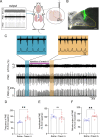Control of breathing by orexinergic signaling in the nucleus tractus solitarii
- PMID: 38553555
- PMCID: PMC10980752
- DOI: 10.1038/s41598-024-58075-x
Control of breathing by orexinergic signaling in the nucleus tractus solitarii
Abstract
Orexin signaling plays a facilitatory role in respiration. Abnormalities in orexin levels correlate with disordered breathing patterns and impaired central respiratory chemoreception. Nucleus tractus solitarii (NTS) neurons expressing the transcription factor Phox2b contribute to the chemoreceptive regulation of respiration. However, the extent to which orexinergic signaling modulates respiratory activity in these Phox2b-expressing NTS neurons remains unclear. In the present study, the injection of orexin A into the NTS significantly increased the firing rate of the phrenic nerve. Further analysis using fluorescence in situ hybridization and immunohistochemistry revealed that orexin 1 receptors (OX1Rs) were primarily located in the ventrolateral subdivision of the NTS and expressed in 25% of Phox2b-expressing neurons. Additionally, electrophysiological recordings showed that exposure to orexin A increased the spontaneous firing rate of Phox2b-expressing neurons. Immunostaining experiments with cFos revealed that the OX1R-residing Phox2b-expressing neurons were activated by an 8% CO2 stimulus. Crucially, OX1R knockdown in these NTS neurons notably blunted the ventilatory response to 8% CO2, alongside an increase in sigh-related apneas. In conclusion, orexinergic signaling in the NTS facilitates breathing through the activation of OX1Rs, which induces the depolarization of Phox2b-expressing neurons. OX1Rs are essential for the involvement of Phox2b-expressing NTS neurons in the hypercapnic ventilatory response.
© 2024. The Author(s).
Conflict of interest statement
The authors declare no competing interests.
Figures





Similar articles
-
Activation of Phox2b-Expressing Neurons in the Nucleus Tractus Solitarii Drives Breathing in Mice.J Neurosci. 2019 Apr 10;39(15):2837-2846. doi: 10.1523/JNEUROSCI.2048-18.2018. Epub 2019 Jan 9. J Neurosci. 2019. PMID: 30626698 Free PMC article.
-
Chemosensitive Phox2b-expressing neurons are crucial for hypercapnic ventilatory response in the nucleus tractus solitarius.J Physiol. 2017 Jul 15;595(14):4973-4989. doi: 10.1113/JP274437. Epub 2017 Jun 16. J Physiol. 2017. PMID: 28488367 Free PMC article.
-
Orexin Facilitates the Peripheral Chemoreflex via Corticotropin-Releasing Hormone Neurons Projecting to the Nucleus of the Solitary Tract.J Neurosci. 2024 Jul 3;44(27):e2383232024. doi: 10.1523/JNEUROSCI.2383-23.2024. J Neurosci. 2024. PMID: 38789262 Free PMC article.
-
Hypothalamic modulation of breathing.Adv Exp Med Biol. 2010;669:243-7. doi: 10.1007/978-1-4419-5692-7_49. Adv Exp Med Biol. 2010. PMID: 20217358 Review.
-
Orexin in Respiratory and Autonomic Regulation, Health and Diseases.Compr Physiol. 2020 Mar 12;10(2):345-363. doi: 10.1002/cphy.c190013. Compr Physiol. 2020. PMID: 32163209 Review.
Cited by
-
Retrotrapezoid nucleus chemoreception: mechanisms of function and contributions to disordered breathing in disease.Trends Neurosci. 2025 Sep;48(9):706-720. doi: 10.1016/j.tins.2025.07.006. Epub 2025 Aug 15. Trends Neurosci. 2025. PMID: 40816914 Review.
-
GABAergic neurons in central amygdala contribute to orchestrating anxiety-like behaviors and breathing patterns.Nat Commun. 2025 Apr 14;16(1):3544. doi: 10.1038/s41467-025-58791-6. Nat Commun. 2025. PMID: 40229297 Free PMC article.
-
Prevalence and Factors Associated with Rapid Eye Movement-Related Obstructive Sleep Apnea in Patients with Narcolepsy.Nat Sci Sleep. 2025 Aug 25;17:1929-1944. doi: 10.2147/NSS.S554593. eCollection 2025. Nat Sci Sleep. 2025. PMID: 40896258 Free PMC article.
-
Whole-brain inputs and outputs of Phox2b and GABAergic neurons in the nucleus tractus solitarii.Front Neurosci. 2024 Jun 14;18:1427384. doi: 10.3389/fnins.2024.1427384. eCollection 2024. Front Neurosci. 2024. PMID: 38948926 Free PMC article.
-
Activation of Centromedial Amygdala GABAergic Neurons Produces Hypotension in Mice.Neurosci Bull. 2025 May;41(5):759-774. doi: 10.1007/s12264-024-01317-9. Epub 2024 Nov 25. Neurosci Bull. 2025. PMID: 39581900
References
MeSH terms
Substances
Grants and funding
LinkOut - more resources
Full Text Sources

